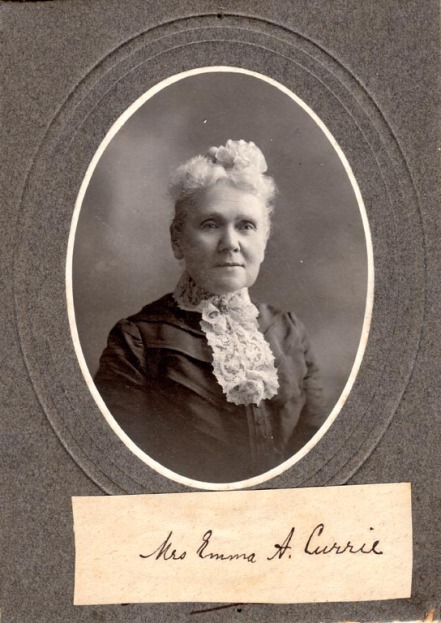
Emma Augusta Currie (nee Harvey, 1829-1913)
Born in the Town of Niagara (today Niagara-on-the-Lake), Emma was the daughter of Ursen Harvey and Caroline Hamlin. Her mother died when she was only 5 months old and Emma was briefly sent to live with her grandmother in East Bloomfield, New York. She returned to Niagara as a young child and moved to St. Davids (a village within Niagara-on-the-Lake) where her father purchased a tannery. Emma attended school in Niagara, St. Davids, East Bloomfield, New York, and then returned to Niagara where she attended a Young Ladies’ seminary.
Emma married late in life, at the age of 36, to a lawyer and Mayor of St. Catharines named James G. Currie (1827-1901). James was also a Member of Provincial Parliament and Speaker of the House. Emma enjoyed a life in the upper middle class that allowed time to participate in social events and many community organizations. She was a major advocate for temperance and was very engaged in the Woman's Christian Temperance Union (WCTU). She was also a major contributor to, and involved in, Our Western Home, a school for British home children in Niagara-on-the-Lake. Further, Emma was the founder of the Women’s Literacy and Historical Club of St. Catharines, which studied and promoted the history of the Niagara Region. The Club also erected several historical markers within our community about significant events in local history. The club grew to over 41 women within the first year and continued meeting until 1994.
Emma and her husband were very involved in the Niagara Historical Society, presenting various historical papers and donating to both the collection as well as the building of Memorial Hall in 1907. Emma was credited by Society President, Janet Carnochan, for the acquisition of genuine Laura Secord artefacts for the Museum’s collection from the War of 1812 heroine’s family. The Museum’s collection also houses a few art pieces created by Emma.
Emma wrote about her life growing up in small town St. Davids, which was published in the Niagara Historical Society’s Publication Number 20. Her reminiscences include depictions of school, the general store, prominent families, races on the commons, the abundance of fruit and nuts, and marveling at the latest advancements in technology- the telegraph and the steamers. She also touches upon her friendship with the infamous Niagara historian and author, William Kirby. He lived with her family when he first arrived in Niagara and enjoyed tutoring her and her brother on various international and historical topics. Kirby called her one of the “cleverest girls he ever knew”.
Emma was also outspoken about social injustices. She was adamantly against Canada’s refusal to admit Chinese or Indian refugees to work here around the turn of the twentieth century. Emma also believed in women’s rights. If women managed the family home, then she believed they should be able to exercise their rights to protect it. She once stated,
“Let us have high ideals and live up to them. Our schools should be the hope of our country. No one can know too much. The great thing is to know the realities of life, its needs and what is our part to do.”
Emma stuck with these ideals when she actively promoted the story of Laura Secord. She was inspired to document Laura’s story after Sarah Ann Curzon wrote a dramatic play in 1887 titled, Laura Secord: The Heroine of 1812. She extensively researched her story through reminiscences from Laura’s relatives and others who survived the War of 1812. She published The Story of Laura Secord and Canadian Reminiscences in 1900. This publication also included stories of other women from the 1812 period. It was very well received at the time and was used to support the creation of the Laura Secord Monument at Queenston Heights in 1910. Reports stated that over 3,000 attended the opening. Emma donated all the profits from the publication towards the development of the monument. Emma also pushed the Dominion government to provide a pension to Laura Secord’s granddaughter in Guelph, Ontario.
In 1898, Emma experienced an accident which confined her to a wheelchair for the rest of her life. She was working on a second volume to her publication when she died in 1913. She is buried in St. Davids.
Locally, Emma has provided invaluable reminiscences on what St. Davids was like in the mid-1800s. Canadians are also indebted to Emma for her written work and promotion of the story of Laura Secord. Laura’s position as a national heroine would not have been possible without Emma and Sarah Ann Curzon’s determination to put a woman’s story in the forefront of Canadian memory.
Sources
Currie, Mrs. J.G “Reminiscences”. Niagara Historical Society Publication Vol. 20. http://www.nhsm.ca/media/NHS20.pdf
Currie, Emma A. “The Story of Laura Secord and Canadian Reminiscences.” William Briggs, Toronto. 1900
James George Currie, MPP - Parliamentary History. Legislative Assembly of Ontario. http://www.ontla.on.ca/web/members/members_all_detail.do?locale=en&ID=776
Niagara Historical Society Scrapbooks, Niagara-on-the-Lake Museum. 987.5.317
Niagara Historical Society Scrapbooks, Niagara-on-the-Lake Museum. 987.5.318
Stevens, Bill. “The Women’s Literary Club of St. Catharines”. St. Catharines Historical Society. https://stcatharineshistory.wordpress.com/2010/12/04/the-womens-literary-club-of-st-catharines/
Friends of Laura Secord. “Celebrating a Hometown Heroine: Emma Currie and the Story of Laura Secord”. http://www.guidetags.com/friends-of-laura-secord/explore/fls-trillium-pois/117-celebrating-a-hometown-heroine-emma-currie-and-the-story-of-laura-secord



